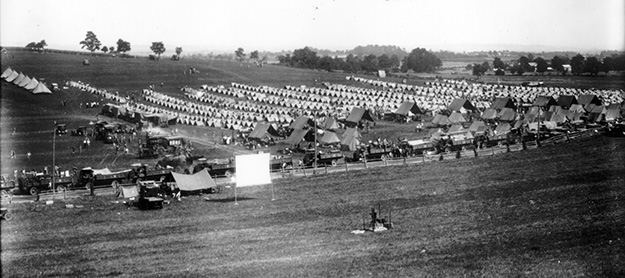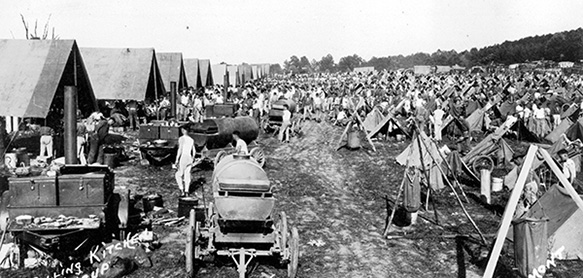by James Rada, Jr.
1922 – The marines Conquer Thurmont
More than a quarter of the U.S. Marine Corps arrived in Thurmont on June 25, along with the equipment to outfit an even larger group. They had been on the march for six days. Their ultimate destination was Gettysburg, Pennsylvania, but first, they had to get through Thurmont.
They ran into a slight snag as they passed north along Church Street. The Western Maryland Railway passed over the road about three blocks north of the downtown square, and there wasn’t enough clearance for the trucks carrying the tanks to pass under the bridge. Heavy timbers had to be placed on the back of the trucks to allow the tanks to be unloaded. The trucks and tanks then passed under the bridge separately. On the other side, the tanks were loaded onto the trucks again.
By 2:30 p.m., the Marines marched into a clover field about a mile north of Thurmont and sat down. Camp Haines was erected on the Hooker Lewis Farm. The Baltimore Sun reported that thousands of visitors came out to the camp to watch the evening movies showing the Marines on their march and to listen to the Expeditionary Force Marine Band play. They also joined in singing the Marine Hymn at the end of the concert.
One of the visitors to the camp was Henry Fleagle, a Civil War Veteran who had fought in 26 major engagements with the Seventh Maryland Infantry and emerged unscathed. Fleagle saw that the Marines had to carry very little during their march and remarked, “It is hard to get used to the new ways of doing things. We had to carry everything with us when we marched.”
“But you didn’t have to hike around like this,” one Marine told him.
“Didn’t, eh? Once we did 30 miles a day, and at the end of it, we had to double time three miles to cut off a part of Lee’s army, Son, you don’t know what hiking is,” Fleagle replied.
He told them about fighting in the Battle of Laurel Hill in Virginia during the Civil War when all but four men in his company were killed.
“Once a bullet took my hat away and another time a spent bullet hit me on the shoulder, but it didn’t have force enough to go in. I hope you boys will be as lucky as that if there’s another war,” Fleagle told the gathered Marines.
He shook hands with many of the Marines and officers and told them that there were only nine Civil War Veterans in the county. Then he thought for a moment, and corrected himself, saying that there may have been only eight left.
By the end of the evening, five other Civil War Veterans had visited the camp: Jacob Freeze, “Dad” Elower, Will Miller, William Stull, and Henry Cover.
After eight hours of marching, some of the Marines willingly hiked back into Thurmont to eat a meal that wasn’t camp rations.
“Until late, they could be seen walking by the roadside, while many stood on running boards of touring cars whose occupants had honored the uniform and given the sea soldiers desirous of ‘seeing the town’ a lift to shorten the journey on foot,” The Washington Post reported.
While in Thurmont, some confusion needed to be sorted out between the Marines and the Commonwealth of Pennsylvania in order for the journey to continue past the Mason-Dixon Line. The Pennsylvania State Highway Department had been told that the Marines were using cleated trucks and tanks that would tear up the road surface. Highway Department officials traveled to Thurmont to inspect the vehicles and make sure that they complied with Pennsylvania law.
As night fell, lights flicked on across the fields, breaking up the darkness. Men made their way back to camp before “Taps” was played. Then they turned in, except for officers who worked on the next day’s plans and night couriers on motorcycles who carried messages north and south.
The next morning, June 26, the Marines made their final 15-mile march through Emmitsburg to Gettysburg, settling in at Camp Harding near the base of the Virginia Memorial on the Gettysburg battlefield. Once there, they would be able to rest somewhat before returning to Quantico.
The morning started off badly when three Marines were injured near Thurmont. The truck in which they were riding went off the road into a ditch on its way to Emmitsburg. The most severe injury sustained among the three men was a fractured shoulder blade.
As the Marines passed through Emmitsburg along Seton Avenue, local Civil War Veterans—Michael Hoke, Jame T. Hostleborn, John H. Mentzer, Thomas E. Frailey, all of whom had served with the First Maryland Cavalry—stood with flags. Mayor J. Henry Stokes, who had three sons who had served in WWI, also greeted the Marines.
At the state line just north of Emmitsburg, the two Maryland state troopers who had been traveling with the Marines to clear the roads in front of them since they had passed into Maryland from the District of Columbia, turned over their duties to seven Pennsylvania state troopers. The Pennsylvania State Police then escorted the East Coast Expeditionary Force on the last leg of their journey on Emmitsburg Road to Camp Harding


Marine Encampment

